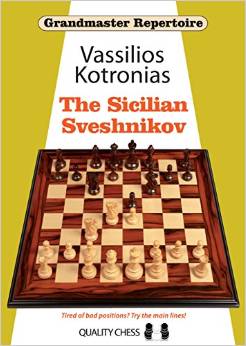Sicilian Sveshnikov, The
Vasilios Kotronias

The Sicilian Sveshnikov by Vasilios Kotronias is the first major work on this popular defense since 2008 and makes all previous efforts superfluous.
First off it should be said the Sicilian Sveshnikov is written primarily from Blacks point of view. Kotronias, although scrupulously objective, presents what he feels are the best lines for Black, not necessarily what has been played most often. One example of this is after 1.e4 c5 2.Nf3 Nc6 3.d4 cxd4 4.Nxd4 Nf6 5.Nc3 e5 6.Ndb5 d6 7.Bg5 a6 8.Na3 b5 9.Nd5 Be7 10.Bxf6 Bxf6 11.c3 0-0 12.Nc2 Bg5 13.a4 bxa4 14.Rxa4 a5 15.Bc4 Rb8 16.b3 Kh8 17.Nce3 he analyses 17…Ne7, which he believe to be better than the more popular 17…g6 (which he dislikes because of 18.h4!?).
Sidelines for Black are generally not offered nor are alternative move orders. The sequence 1.e4 c5 2.Nf3 Nc6 3.d4 cxd4 4.Nxd4 Nf6 5.Nc3 e5 6.Ndb5 d6 7.Bg5 a6 8.Na3 b5 9.Bxf6 gxf6 10.Nd5 is met by only 10… f5 not 10… Bg7. Nor is the move order 1.e4 c5 2.Nf3 e6 3.d4 cxd4 4.Nxd4 Nf6 5.Nc3 Nc6 to be found, angling for the Sveshnikov after 6.Ndb5 d6 7.Bf4 e5 8.Bg5.
Instead every possible White try after 1.e4 c5 2.Nf3 Nc6 3.d4 cxd4 4.Nxd4 Nf6 5.Nc3 e5 is examined. Even the sidelines 6.Nf3, 6.Nb3, 6.Nxc6 and 6.Nf5 are given over 20 pages while 6.Ndb5 d6 7.a4, 7.Be3 and 7.Nd5 merit more than 50 pages.
The bulk of the Sicilian Sveshnikov is of course devoted to the main lines after 1.e4 c5 2.Nf3 Nc6 3.d4 cxd4 4.Nxd4 Nf6 5.Nc3 e5 6.Ndb5 d6 7.Bg5 a6 8.Na3 b5 9.Nd5 and 9.Bxf6. Here Kotronias sometimes faces a challenge in finding current games as great Sveshnikov champions like Gelfand and Radjabov get few chances to use their favorite these days. Even high-rated opposition employs the Rossolimo and the move order 1.e4 c5 2.Nf3 Nc6 3.Nc3 to dodge the Sveshnikov. The idea of the latter is if Black plays 3… Nf6 (hoping for 4.d4 cxd4 5.Nxd4 e5) White has 4.Bb5 and the second player has fewer options than usual against the Rossolimo. Some Black defenders like Gelfand prefer 3… e5 and others (like Vachier-Lagrave against Carlsen at the recent Sinquefield Cup) 3… g6 entering the Accelerated Dragon having avoided the Maroczy Bind.
Kotronias gets around the lack of current tournament examples in some main lines by drawing on correspondence games and also offering a great number of theoretical novelties when needed. One example occurs after 1.e4 c5 2.Nf3 Nc6 3.d4 cxd4 4.Nxd4 Nf6 5.Nc3 e5 6.Ndb5 d6 7.Bg5 a6 8.Na3 b5 9.Bxf6 gxf6 10.Nd5 f5 11.Bd3 Be6 12.c3 Bg7 13.Qh5 0-0 14.exf5 Bxd5 15.f6 h6!? 16.fxg7 Kxg7 17.Nc2! Be6! 18.Ne3 d5 19.h4 Qf6 20.Bf5 Bxf5 21.Nxf5+ Kh7 22.Rd1 Rad8 23.Rh3 Qg6 24.Qxg6+ fxg6 25.Ne3 d4 26.Nc2 Rf4 27.Rd2 h5 28.b3, Anand-Ivanchuk, Linares 2002.
Black could have played: 28 …Kg7!? Intending to pressure c3 by means of a5 and b4. This would force cxd4, freeing e5 for the black knight and giving Black some chances of success.
Anyone who plays the Sveshnikov or is considering taking it up should buy the Sicilian Sveshnikov.
Highly Recommended
